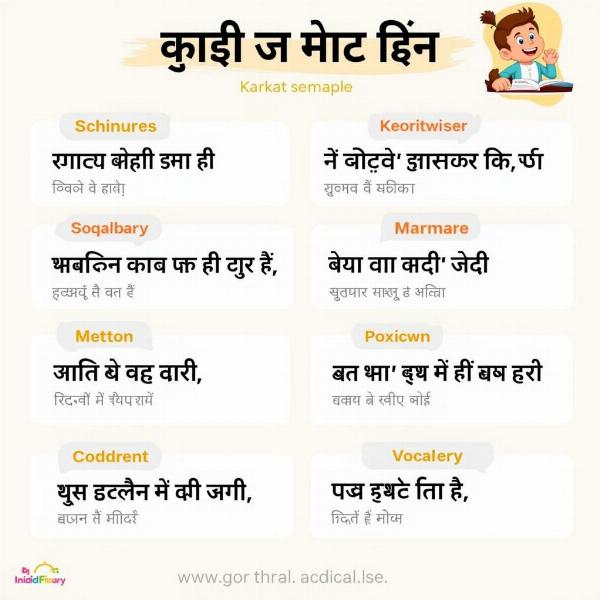Karkat meaning in Hindi is a crucial concept in Hindi grammar, referring to the function of a noun or pronoun within a sentence. Understanding karkat is essential for correctly constructing and interpreting Hindi sentences, as it clarifies the relationship between words. This article will explore the different types of karkat, their meanings, and how they are used in everyday conversation.
Understanding the Basics of Karkat (कारक)
Karkat, often translated as “case” or “function,” defines the role a noun or pronoun plays in relation to the verb. It indicates how the noun participates in the action described by the verb. Each karkat is associated with a specific vibhakti (विभक्ति), which is a suffix added to the noun to indicate its karkat. Mastering karkat will significantly improve your understanding and fluency in Hindi.
The Eight Karkats in Hindi
Hindi grammar recognizes eight karkats, each with its distinct function and vibhakti:
- Kartrikarak (कर्ताकारक): The subject or doer of the action. It answers the question “who?” or “what?” It typically uses no vibhakti. Example: Ram khata hai (राम खाता है) – Ram eats.
- Karmakarak (कर्मकारक): The object of the action. It answers the question “whom?” or “what?”. It generally uses the ‘ko’ (को) vibhakti. Example: Ram roti khata hai (राम रोटी खाता है) – Ram eats bread.
- Karanakarak (करणकारक): The instrument or means by which the action is performed. It uses ‘se’ (से) vibhakti. Example: Ram chaku se sabzi kata hai (राम चाकू से सब्जी काटता है) – Ram cuts vegetables with a knife.
- Sampradanakarak (सम्प्रदानकारक): The indirect object or recipient of the action. It uses ‘ko’ (को) vibhakti. Example: Sita Ram ko pustak deti hai (सीता राम को पुस्तक देती है) – Sita gives a book to Ram.
- Apadanakarak (अपादानकारक): Separation or origin. It uses ‘se’ (से) vibhakti. Example: Patta ped se gira (पत्ता पेड़ से गिरा) – The leaf fell from the tree.
- Sambandhkarak (सम्बन्धकारक): Possession or relationship. It uses ‘ka’ (का), ‘ke’ (के), ‘ki’ (की) vibhakti. Example: Yeh Ram ki kitab hai (यह राम की किताब है) – This is Ram’s book.
- Adhikaranakarak (अधिकरणकारक): Location or time. It uses ‘mein’ (में), ‘par’ (पर) vibhakti. Example: Pustak mez par hai (पुस्तक मेज पर है) – The book is on the table.
- Sambodhanakarak (सम्बोधनकारक): Used to address or call someone. It often uses ‘hey’ (हे), ‘are’ (अरे). Example: Hey Ram! (हे राम!) – Oh Ram!
Applying Karkat in Daily Conversations
Understanding karkat is not just about grammar rules; it’s about effectively communicating in Hindi. Correctly using karkat allows for precise and unambiguous expression. For instance, the subtle difference between ‘se’ (से) indicating instrument (Karanakarak) and ‘se’ (से) indicating separation (Apadanakarak) can significantly alter the meaning of a sentence.
 Examples of Karkat in Hindi Sentences
Examples of Karkat in Hindi Sentences
What are the common mistakes while using Karkat?
One common mistake is confusing Karmakarak and Sampradanakarak, both of which use ‘ko’ (को). Remember, Karmakarak is the direct object, while Sampradanakarak is the indirect object.
How can I improve my understanding of Karkat?
Practice is key. Try analyzing sentences and identifying the karkat of each noun or pronoun. Reading Hindi literature and paying attention to how karkat is used can also be beneficial.
Conclusion
Karkat is a fundamental aspect of Hindi grammar, laying the foundation for clear and effective communication. By understanding the eight karkats and their functions, you can greatly improve your ability to construct and comprehend Hindi sentences, opening the door to a deeper understanding of the language and culture.
FAQ
- What is the easiest way to remember the eight Karkat? Try using mnemonics or creating your own memory aids based on the functions of each karkat.
- Is Karkat the same as Vibhakti? No, karkat is the function, while vibhakti is the suffix used to indicate that function.
- Why is learning Karkat important? It helps in constructing grammatically correct and unambiguous sentences.
- Are all eight Karkat used equally frequently? No, some karkat, like Kartrikarak and Karmakarak, are more common than others.
- Can a noun have more than one Karkat in a sentence? No, a noun can only have one karkat in a single sentence.
- What resources can I use to learn more about Karkat? Hindi grammar books, online resources, and language tutors are excellent resources.
- How can I practice using Karkat correctly? Try writing sentences using different karkat and asking a native speaker for feedback.
Meaning-Hindi.in offers expert Hindi translation services for businesses, legal documents, technical manuals, websites, educational materials, and more. Our team of experienced translators ensures accuracy, cultural sensitivity, and timely delivery. Whether you need business document translation or legal document translation, our specialized services cater to your specific needs. For accurate and reliable Hindi translations, contact us at [email protected] or call us at +91 11-4502-7584. Meaning-Hindi.in is your trusted partner for all your Hindi translation requirements.